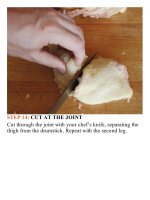The food lab better home cooking through science ( PDFDrive ) 105
Bạn đang xem bản rút gọn của tài liệu. Xem và tải ngay bản đầy đủ của tài liệu tại đây (177.08 KB, 2 trang )
boiledeggs,ontheotherhand,shouldhavefullysetwhites
with liquid yolks that ooze out like a soft custard, bathing
your toast in their golden flow and enriching your crisp
bacon.There’s more to boiling an egg than meets the eye.
Muchmore.
Nearlyeverybasiccookbookoffersadifferenttechnique
for how it should be done: start the egg in cold water, or
gentlyloweritintoboilingwater;addvinegartothewaterto
lower its pH, or add baking soda to the water to raise it;
cover the pot, or don’t cover it; use old eggs, or use new
eggs;andonandon.Butveryfewofferevidenceastowhy
any one of these techniques should work any better than
another.Apparently, boiling eggs is not . . . ahem . . . an
eggsactscience.Let’stryandchangethat.
WhatIsBoiling?
First things first: what exactly is boiling? The technical
definition is that it is what occurs when the vapor pressure
of a liquid is greater than or equal to the atmospheric
pressurethatsurroundsit.Let’sgobacktothechickencoop
analogy we usedhere.Your pot of water is a coop full of
chickens.The chickens tend to like each other and happily
sticktogetherinsidethecoop.Now,let’ssaywestartadding
energy to the mix by switching their water supply out with
coffee. With the added energy, the chickens begin to
becomehyperactive—oneortwoofthemmightevenbeso
energetic as to be able to jump the fence and escape.Add
enoughenergytothemix,andeventuallythechickenswill
becomesohyperactivethatthey’llteardownthefenceand
beginescapingveryrapidlyindeed.
Boilingwateristhesamething.Thewatermoleculesare
trappedinthepotandkeptinplacebytheirownfence—the
pressureoftheairintheatmospherepushingdownonthem.
Add energy to the pot in the form of heat, and water
moleculesbegintostartleapingoffthesurfaceofthewater.
Thisiscalledevaporation.Eventuallythepressureproduced
bythewatermoleculestryingtoescapebecomesequaltoor
greater than the pressure of the atmosphere pushing down
on it. The fence breaks, the floodgates open, and water
moleculesrapidlyjumpfromaliquidstatetogas,bubbling
upviolently.Thisconversionofliquidwatertowatervapor
(steam) is what you see when you look at a pot of boiling
water; with pure water at sea level, this occurs at 212°F
(100°C).
Here’saquickrundownofwhathappenswhenyoubring
apotofwatertoaboil:
• Quivering:Atbetween130°and170°F, tiny bubbles of
water vapor begin forming at nucleation sites (more on
those later) along the bottom and sides of the pot.They
won’t be large enough to actually jump and rise to the
surfaceofthewater,buttheirformationwillcausethetop
surfacetoquiverabit.









